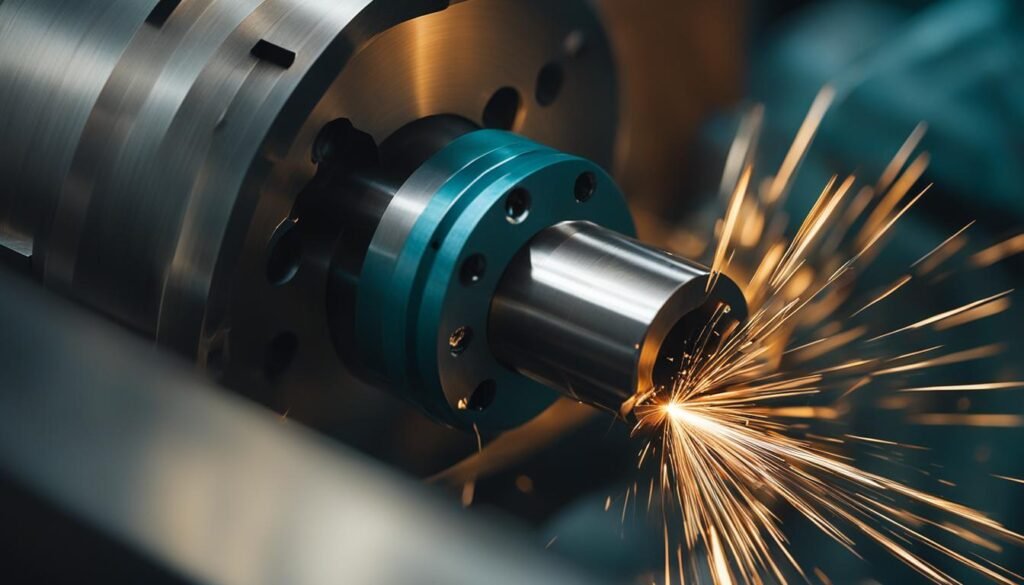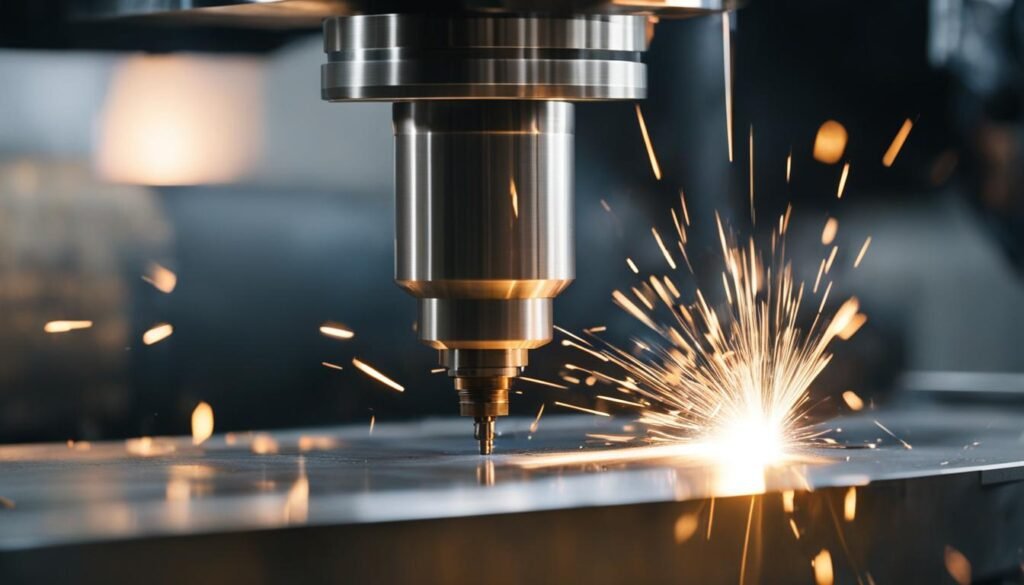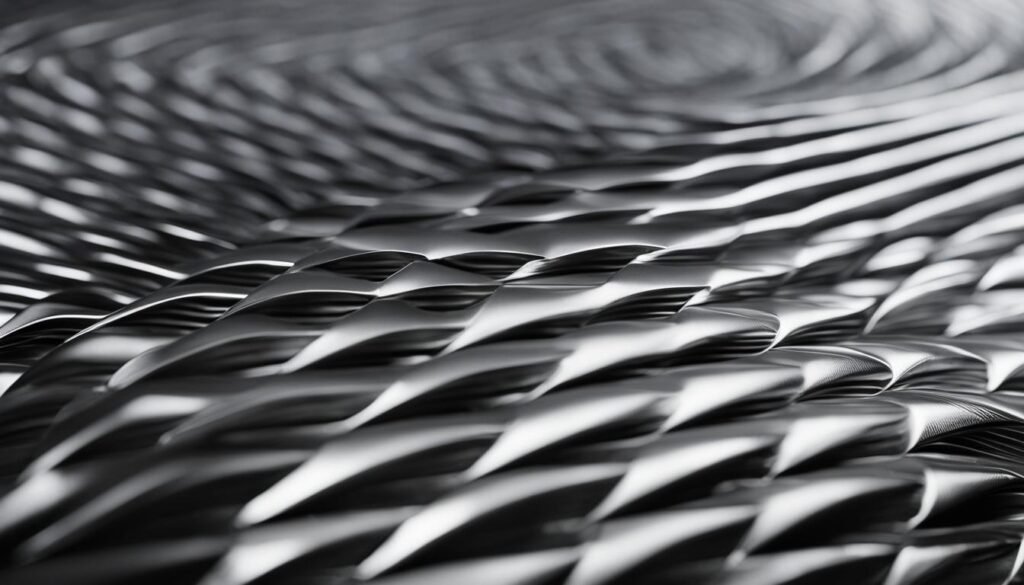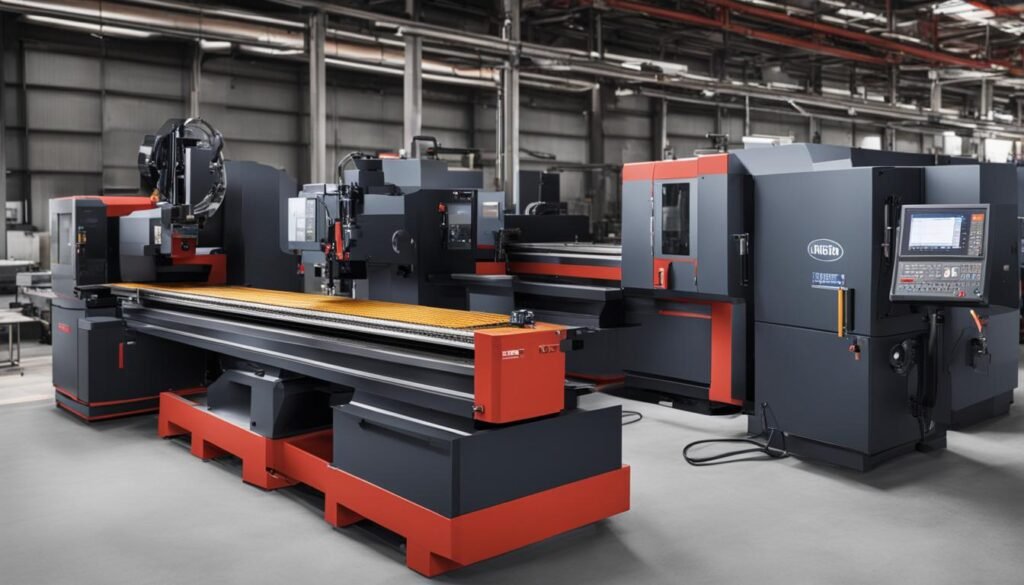Key Takeaways:
- Turning and milling are precision machining processes used for removing material from stock material.
- Turning involves rotating the workpiece, while milling moves the cutting tool.
- Turning is faster and more efficient for producing smaller parts, while milling offers flexibility for complex shapes.
- Consider part design, features, size, shape, and material when choosing between turning and milling.
- Both processes have advantages and can be used effectively depending on project requirements.
The Similarities between Turning and Milling
Both turning and milling are commonly used in subtractive manufacturing processes. They utilize CNC technology and are suitable for a range of materials, including metals and thermoplastics. There are several key similarities between these two machining methods.- Subtractive Manufacturing: Both turning and milling fall under the category of subtractive manufacturing, which involves the removal of unwanted material from a stock material to create the desired shape.
- CNC Technology: Both processes rely on computer numerical control (CNC) technology, allowing for precise programming and consistent quality in the machining process.
- Suitable Materials: Turning and milling are suitable for various materials, including metals like aluminum, steel, brass, copper, titanium, as well as thermoplastics.
- Heat Generation: Both processes generate heat during the machining process, which can have implications for the machining efficiency and tool life. To mitigate this issue, cutting fluids are often used to dissipate heat and lubricate the cutting tool.
“Both turning and milling are important processes in the field of manufacturing. They share common aspects, such as the use of CNC technology and the ability to work with various materials. Understanding the similarities between turning and milling can help manufacturers make informed decisions when choosing the right machining method for their projects.”Overall, turning and milling offer similar advantages and are both essential in the world of precision machining. The key is to assess the specific needs of each project and consider factors such as part design, complexity, size, and material to determine the most appropriate method to achieve the desired outcome.
| Similarities | Turning | Milling |
|---|---|---|
| Subtractive Manufacturing |  |
 |
| CNC Technology | ✓ | ✓ |
| Suitable Materials | ✓ | ✓ |
| Heat Generation | ✓ | ✓ |
The Distinctions of CNC Turning
CNC turning is a precision machining process that involves using a chuck to hold the round bar stock, while a spindle spins the chuck and the workpiece. This rotational movement allows for the application of a stationary cutting tool to remove material and create the desired features. CNC lathes are the machines used for turning, and they come in different types with various tooling options, spindle options, and outer diameter limitations. One key feature of some turning centers is the presence of a main and sub-spindle, which allows for more complex machining on both ends of the component. This capability is particularly useful for creating parts with intricate designs and multiple features. Additionally, some CNC Swiss turning machines utilize “live” tooling, which enables the addition of further features during the turning process. Compared to milling, CNC turning is generally faster and more efficient for producing smaller parts. It is well-suited for creating axially symmetric components such as cylinders or cones. The use of single-point turning tools in turning centers ensures precise and accurate machining. Furthermore, turning produces chips as waste, which can be easier to manage compared to the discontinuous chips produced during milling.Table: Comparison of CNC Turning and CNC Milling
| Aspect | CNC Turning | CNC Milling |
|---|---|---|
| Machine | CNC lathes | Milling machines |
| Tooling | Single-point turning tools | Multi-point cutting tools |
| Material Shape | Axially symmetric (cylinders, cones) | Flat or sculptured surfaces |
| Waste | Chips | Discontinuous chips |
The Distinctions of CNC Milling
When it comes to precision machining, CNC milling stands out as a versatile and efficient process. Unlike turning, where the workpiece rotates while the cutting tool remains stationary, CNC milling involves the movement of the cutting tool while the workpiece remains stationary. This fundamental distinction allows milling machines to offer flexibility in creating complex shapes and working with various materials. In CNC milling, different machine configurations can be used to achieve desired results. The basic concept involves the cutting tool shaving off material from the workpiece to create the desired shape. The cutting tools used in milling can have multiple cutting surfaces, which allows for more efficient material removal. This ability to remove material in different directions and angles makes milling suitable for flat or sculptured surfaces. One of the key advantages of CNC milling is the ability to work with a wide range of materials. From metals like aluminum, steel, and brass to different types of plastics, milling machines can accommodate diverse material requirements. Additionally, milling machines can be equipped with various tooling options, such as different types of cutters, to further enhance their capabilities. Overall, CNC milling offers a distinct set of advantages over turning. Its flexibility in producing complex shapes, working with different materials, and utilizing multiple cutting surfaces makes it a preferred choice for many precision machining projects.Table: Comparison of CNC Turning and CNC Milling
| Aspect | CNC Turning | CNC Milling |
|---|---|---|
| Workpiece Movement | Rotation | Stationary |
| Cutting Tool Movement | Stationary | Moves in multiple directions |
| Shape Capabilities | Cylindrical or conical | Flat or sculptured |
| Material Compatibility | Metals and thermoplastics | Wide range of materials |
 As shown in the comparison table, CNC milling and turning have distinct differences in terms of workpiece and cutting tool movement, shape capabilities, and material compatibility. Understanding these distinctions is crucial for selecting the most suitable machining process for your project. Whether you need cylindrical or conical shapes produced through turning or require the flexibility and complexity of milling, both processes have their own unique advantages in precision machining.
As shown in the comparison table, CNC milling and turning have distinct differences in terms of workpiece and cutting tool movement, shape capabilities, and material compatibility. Understanding these distinctions is crucial for selecting the most suitable machining process for your project. Whether you need cylindrical or conical shapes produced through turning or require the flexibility and complexity of milling, both processes have their own unique advantages in precision machining.
Turning Vs Milling Overview
When it comes to the method of operation, turning and milling have distinct differences. Turning involves rotating the workpiece, while milling moves the cutting tool. This fundamental distinction impacts the resulting shapes that can be achieved with each process. Turning is ideal for producing cylindrical or conical shapes, while milling is better suited for creating flat or sculptured surfaces. The machines used in turning and milling also differ. Lathes are commonly used for turning, while milling machines are employed for milling operations. Additionally, the tools used in these processes vary. Turning utilizes single-point turning tools, while milling employs multi-point cutting tools. Understanding these differences is crucial when determining the most suitable manufacturing method for your project.Quote: “Turning involves rotating the workpiece, while milling moves the cutting tool.”Another important consideration is the waste produced during turning and milling. Turning typically generates chips as waste, while milling produces discontinuous chips. The type of waste produced can impact the overall production process and the necessary steps for waste management and disposal.
| Turning Vs Milling Overview | |
|---|---|
| Method of Operation | Turning: Rotates the workpiece Milling: Moves the cutting tool |
| Resulting Shapes | Turning: Cylindrical or conical shapes Milling: Flat or sculptured surfaces |
| Machines Used | Turning: Lathes Milling: Milling machines |
| Tools Used | Turning: Single-point turning tools Milling: Multi-point cutting tools |
| Waste Produced | Turning: Chips Milling: Discontinuous chips |
Milled Features on a Turned Part
While turning and milling are distinct precision machining processes, there are instances where milled features can be incorporated into a turned part. This combination allows for greater design flexibility and can be especially useful when creating complex components. By utilizing both turning and milling techniques, manufacturers can achieve the desired design and functionality of a part. In some cases, a turned part may require additional milled features to achieve specific design requirements. For example, a component with mostly turned features may require a flat cutaway section that is best achieved through milling. This combination of turning and milling allows for the creation of intricate shapes and details that may not be feasible with just one machining process.By incorporating milled features on a turned part, manufacturers can take advantage of the strengths of both processes and achieve a higher level of precision and complexity in their components.One key advantage of incorporating milled features on a turned part is the ability to create more intricate geometries. While turning is ideal for producing cylindrical or conical shapes, milling allows for the creation of flat or sculptured surfaces. This combination opens up new possibilities in terms of part design and functionality, enabling manufacturers to meet the specific needs of their projects. Overall, the incorporation of milled features on a turned part showcases the versatility of precision machining processes. By leveraging the strengths of both turning and milling, manufacturers can achieve a wider range of design options and create highly customized components.

Choosing Between Turning and Milling
When deciding between turning and milling for your project, it is essential to consider the part design and features. Large square or flat parts with features are typically better suited for milling, as the process offers flexibility in producing complex shapes. On the other hand, cylindrical parts with features are usually more efficiently produced through turning. If your project involves large square or flat parts that require intricate features, milling is the recommended choice. Milling machines allow for the creation of precise and detailed shapes, making them ideal for such requirements. Additionally, milling offers the advantage of working with various materials, further enhancing its versatility. However, if you require cylindrical parts with features, turning is the preferred option. Turning is well-suited for axially symmetric parts and is typically faster and more efficient for producing smaller components. With the right CNC Swiss or CNC turning center, you can achieve the desired size and diameters with ease.| Decision Factors | Turning | Milling |
|---|---|---|
| Part Design | Axially symmetric parts | Complex shapes |
| Features | Smaller components | Intricate shapes |
| Size and Shape | Cylindrical parts | Square or flat parts |
| Materials | Metals and thermoplastics | Various materials |
Advantages and Disadvantages of Turning and Milling
When it comes to precision machining processes, both turning and milling have their own advantages and disadvantages. Understanding these factors can help you make an informed decision for your project. Let’s take a closer look at the advantages and disadvantages of turning and milling.Advantages of Turning:
- Faster Production: Turning is known for its speed and efficiency, making it the preferred choice for producing smaller parts.
- Higher Efficiency: Turning machines can often produce multiple parts simultaneously, increasing overall productivity.
- Smaller Parts: Turned parts are typically smaller in size, making them suitable for applications where space is limited.
Advantages of Milling:
- Flexibility: Milling offers greater flexibility in creating complex shapes and working with a variety of materials.
- Wide Range of Materials: Milling machines can handle various materials, including metals and thermoplastics.
Disadvantages of Turning:
- Limited Shape and Size: Turning is best suited for axially symmetric parts, limiting the shapes and sizes that can be achieved.
Disadvantages of Milling:
- Post-Processing: Some features produced by milling may require additional post-processing, adding time and cost to the project.
- Limitations in Internal Corners: Internal corners in milled parts may have limitations, requiring special tooling or additional processes.

Conclusion
When it comes to choosing between turning and milling, several factors come into play. The deciding factor relies on various considerations including part design, features, size, shape, and material. Axially symmetric parts are better suited for turning, while milling offers flexibility in producing complex shapes. It is crucial to weigh the capabilities of the machining equipment and the requirements of your project before making a decision. Turning is known for its faster production of smaller parts and higher efficiency. On the other hand, milling provides the advantage of working with various materials and the flexibility to create intricate designs. In your final thoughts on turning and milling, keep in mind that turning and milling processes have their own advantages and can be effectively used depending on the specific needs of your project. Whether you choose turning or milling, your decision should be based on the desired outcome and the specific characteristics of the part you need to manufacture.FAQ
Which is better, turning or milling?
The choice between turning and milling depends on factors such as part design, features, size, shape, and material. Turning is better suited for axially symmetric parts, while milling offers flexibility for complex shapes.
What is the difference between turning and milling?
Turning involves rotating the workpiece, while milling moves the cutting tool. Turning produces cylindrical or conical shapes, while milling is suitable for flat or sculptured surfaces.
What are the advantages of turning and milling?
The advantages of turning include faster production of smaller parts and higher efficiency. Turned parts are also often smaller than milled parts. The advantages of milling include flexibility in producing complex shapes and working with various materials.
What materials are suitable for turning and milling?
Both turning and milling are suitable for metals like aluminum, steel, brass, copper, and titanium, as well as thermoplastics.
What machines are used for turning and milling?
Turning uses machines called lathes, while milling uses milling machines.
How are chips produced in turning and milling?
Turning produces chips as waste, while milling produces discontinuous chips.
Can milled features be added to a turned part?
Yes, small milled features can often be machined on a part that was produced using turning equipment, depending on the size, complexity, and material type of the part.
How do I choose between turning and milling?
The choice between turning and milling depends on factors such as part design, features, size, shape, and material. Large square or flat parts with features are typically milled, while cylindrical parts with features are usually turned. It’s important to consider the capabilities of the machining equipment and the requirements of the project.
What are the advantages and disadvantages of turning and milling?
The advantages of turning include faster production of smaller parts and higher efficiency. The disadvantages may include limitations in shape and size. The advantages of milling include flexibility in producing complex shapes and working with various materials. The disadvantages may include additional post-processing for certain features and limitations in internal corners.
Which process is more efficient, turning or milling?
Turning is generally faster and more efficient for producing smaller parts, while milling offers flexibility for creating complex shapes.
Which type of milling machine is better suited for turning projects?
When considering turning projects, it is essential to choose the appropriate type of milling machine. Different types of milling machines can vary in terms of their suitability for turning tasks. Factors such as spindle orientation, tooling options, and the ability to handle complex shapes should be considered to determine which type of milling machine is better suited for turning projects.
